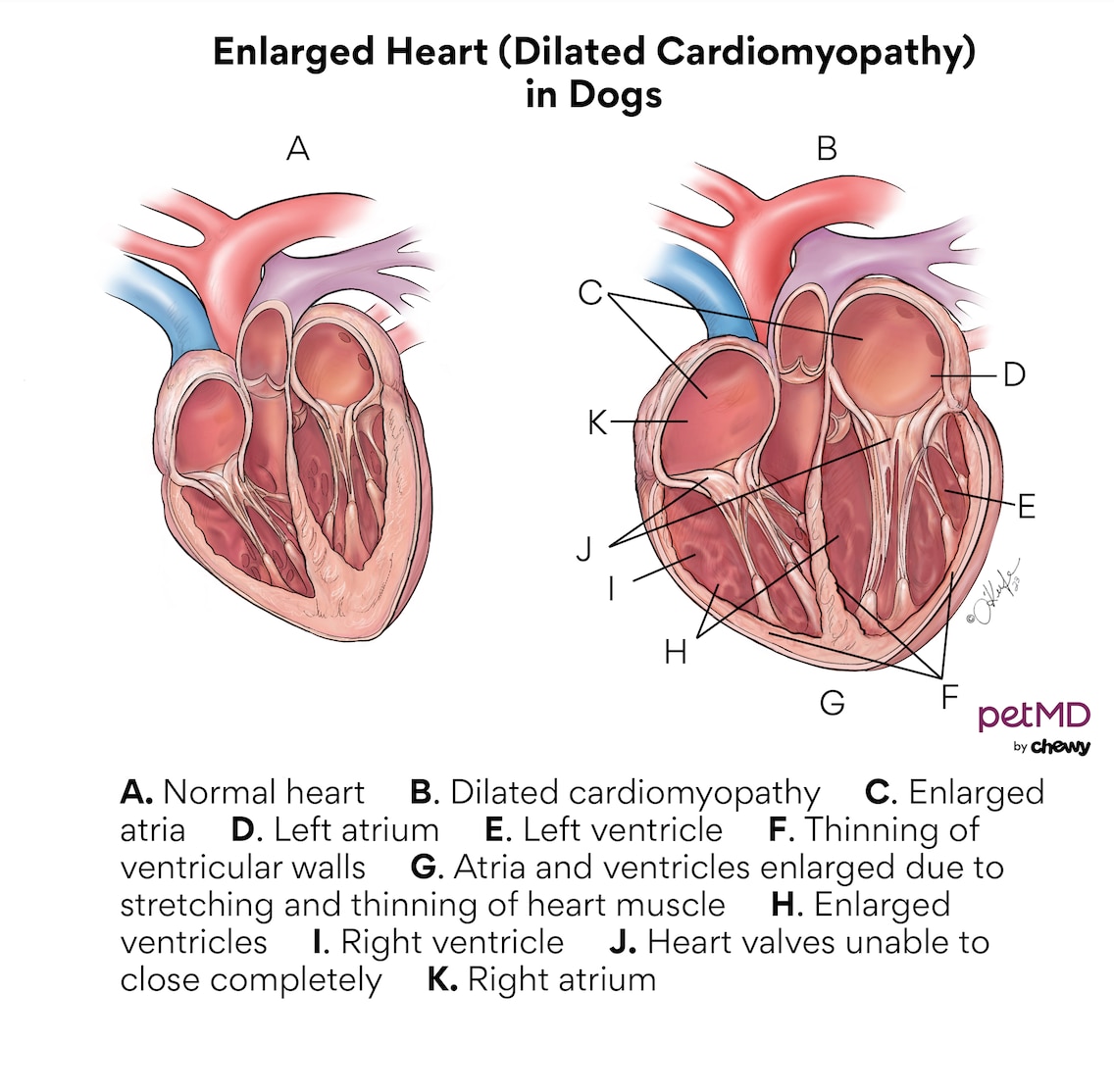Enlarged Heart (Dilated Cardiomyopathy) in Dogs
What Is Dilated Cardiomyopathy in Dogs?
Dilated cardiomyopathy (DCM) is one of the most common heart diseases in large-breed dogs. With DCM, the dog’s heart becomes enlarged as the heart muscle weakens–becoming thinner and stretched out.
The heart has four chambers arranged in a square. The two top chambers are the left and right atrium, while the two bottom chambers are the left and right ventricles. Blood travels from the body into the right side of the heart, where it then moves into the lungs through the pulmonary arteries. In the lungs, the blood picks up oxygen that it brings back into the left side of the heart before being pumped back to the rest of the body. This process allows the body’s cells to receive oxygen essential for life functions.
The oxygenated blood fuels dogs’ muscles in their legs, allowing them to run, jump, and play. It feeds their intestinal tract to help with digestion of food and absorption of nutrients. It fuels the kidneys and the liver so that they can remove toxins and waste products from the blood. Every organ in a dog’s body needs the oxygenated blood that the heart pumps out. In dogs that have DCM, their ventricles start to wear down and become thin and weak. This makes it more difficult for them to pump that enriched blood back out to the body.
While DCM develops slowly over time, it is often subtle and goes unnoticed by pet parents Dogs may develop heart failure suddenly and require emergency care. DCM may also progress to congestive heart failure (CHF), which is considered a medical emergency because it can be fatal in a matter of hours.

Symptoms of DCM in Dogs
DCM can come on abruptly–a seemingly normal dog may show serious clinical signs or even suddenly die. These signs can come from a lack of oxygenated blood going out to the body, resulting in fatigue or poor appetite, or they can be a result of fluid backing up from the heart into the lungs, making it difficult to breathe.
Symptoms for DCM include:
-
Rapid breathing
-
Difficulty lying down or getting comfortable, restlessness
-
Blue tinge to gums or tongue
-
Wet cough or hack
-
Increased effort while breathing, chest heaving
-
Tiring easily, intolerance to exercise
-
Lethargy or weakness
-
Decreased appetite
-
Distended (swollen) belly
-
Fainting or collapse
Causes of DCM in Dogs
Dilated cardiomyopathy can be caused by several factors, including genetics, nutrition, and infections. It has long been linked in part to genetics because several breeds are more likely to be affected.
DCM occurs typically in large-breed dogs, most commonly:
While DCM is more common in large-breed dogs, English Springer Spaniels, Cocker Spaniels, and Portuguese Water Dogs also have an inherited trait that can predispose them to the condition.
Grain-Free Food and DCM in Dogs
In 2018, the U.S. Food and Drug Administration and the Food and Drug Administration’s Center for Veterinary Medicine began investigating the link between grain-free diets and dilated cardiomyopathy. This came after some veterinary cardiologists saw higher numbers of cases of DCM in dogs that were not genetically affected breeds, such as Golden Retrievers.
In 2019, the FDA released a report stating that more than 90% of DCM cases reported to the FDA were dogs who were fed grain-free diets. Many of these diets contained peas and other legumes or lentils as main ingredients, in place of traditional grains. Some of the implicated diets were raw food, vegetarian, or vegan diets.
This began the discussion of “BEG” diets in the veterinary community, an acronym for boutique, exotic, and grain-free diets. Initially, it was believed that the issue was related to a potential deficiency of taurine, an essential nutrient, in these diets. This came from released reports that many Golden Retrievers seemed to respond well to taurine supplementation in treating their DCM. Since then, it has been found that DCM may be more complicated than just one ingredient, and many factors can play a role in causing it.
Many veterinarians advise against feeding grain-free diets; however, some dogs with allergies may be recommended for specific BEG diets to manage their disease. It is important to talk to your veterinarian about good nutrition and what is best for your pet’s health and wellness. They may recommend that you see a veterinary nutritionist to come up with a unique diet tailored to your pet’s needs.
If you are feeding a BEG, vegetarian/vegan, raw, or homemade diet, talk to your veterinarian about recommended monitoring to avoid secondary acquired nutritional disease, like DCM. Your veterinarian may recommend measuring blood and plasma taurine levels, supplements with specific vitamins or minerals, or more frequent imaging to ensure that no problems are developing because of your dog’s diet.
How Veterinarians Diagnose DCM in Dogs
DCM is diagnosed by a combination of tests. Your veterinarian will start by listening to your dog’s heart for the presence of a murmur or arrhythmia (abnormal rhythm). They will also listen for any dampened (muffled) lung sounds or crackles that may show fluid buildup in the lungs. They will take x-rays to look at the size of the heart and check for any enlargement or fluid.
Additionally, they may run bloodwork and look at urine to screen for underlying kidney disease, as many patients have heart and kidney disease at the same time. They may also run a ProBNP test, which looks for high amounts of a specific protein that goes along with stretching or damage to the heart muscle.
If DCM is diagnosed or suspected, your veterinarian may recommend referral to a veterinary cardiologist. The cardiologist can do a heart ultrasound , called an echocardiogram. This allows them to look at each chamber of the heart and to watch the blood flow through the heart. They will also do an ECG, or electrocardiogram, to look at electrical current in the heart to diagnose any abnormal rhythms.
Treatment of DCM in Dogs
DCM is most often treated with medications that help to decrease the workload of the heart or improve the efficiency of the heart’s work, and to remove any fluid from the lungs to make breathing easier.
-
This disease is managed rather than cured. While there is no cure for DCM, dogs that have nutritionally acquired DCM that is caught early can restore normal heart function with the right therapy. The most common medications prescribed in patients with DCM and congestive heart failure include:
-
ACE inhibitors, like enalapril or benazepril, which work to expand the veins leaving the heart and reduce resistance so that it is easier for the heart to pump blood back out to the body.
-
Diuretics, like furosemide or spironolactone, which help to remove fluid from the lungs to make breathing easier for dogs with congestive heart disease.
-
Inotropic drugs, which change the force of the heart’s contractions. Medication like pimobendan is commonly prescribed and works to improve heart muscle strength. Pimobendan helps to increase the strength of heart muscle contractions and lower the pressure in the arteries and veins.
-
Beta blockers act as anti-arrhythmic drugs. More commonly prescribed beta blockers include sotalol, atenolol, and carvedilol. Calcium channel blockers like diltiazem may also be prescribed. A cardiologist may prescribe any of these medications if irregular heart rhythms are diagnosed. These drugs work by acting on the heart’s electrical channels.
-
Nutritional therapy may be needed in the management of heart disease. Sodium-restricted diets may be helpful, like Royal Canin Veterinary Diet Cardiac or Hills Prescription Diet h/d. Additionally, taurine, coenzyme Q10, or carnitine supplements may be recommended.
-
Bronchodilators, like theophylline, and cough suppressants, like hydrocodone or butorphanol, may be prescribed to make breathing easier and reduce cough frequency associated with congestive heart failure.
Recovery and Management of DCM in Dogs
Management of DCM is lifelong in dogs. Heart disease is progressive over time, and there are many factors that can change the prognosis, including: your dog’s breed, if the disease is related to nutrition, and how severe the disease is at the time of diagnosis.
Some breeds, like Doberman Pinschers, have more aggressive forms of this disease, with an average survival time of three months after diagnosis. Other breeds, like Cocker Spaniels, more commonly have a slower progression of DCM, living an average of 6 months to two years after time of diagnosis.
If a taurine deficiency is found and adjusted, the heart’s function can improve quite a bit. But if your dog is already in congestive heart failure at the time of diagnosis, this may make their prognosis worse. Dogs with dilated cardiomyopathy caught early in the disease process may have a better prognosis and live comfortable lives for years.
References
Help us make PetMD better
Was this article helpful?
